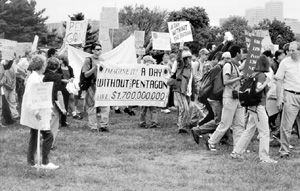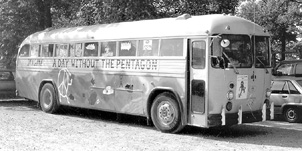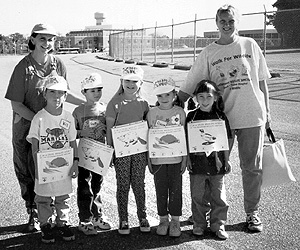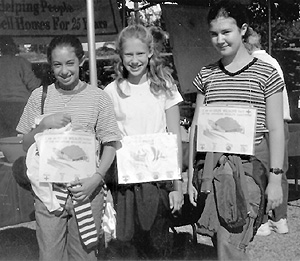
Dock of the Bay

Volume VI Number 43
October 29 - November 4, 1998
Campaign '98: Candidates Seek
Support, Sanity at Trail's End
Marcia Richard, a 33rd District Democratic candidate for delegate, had met all manner of voters this campaign, among them an older gentleman who turned out to chauffeur for Franklin Delano Roosevelt.
Candidates never know who'll open that door they pound on, including
the woman who said to Richard: "I thought you were tall and thin."
Replied the sturdy but barely plump Richard: "So did I."
Insults and rejection are part of the job, and the job in the waning days of the political season has gotten grueling. Aspirants dart across their counties to building dedications, civic meetings, fraternal lodges and church festivals. They never know whom they'll see. Or whether they'll see the same people they just saw. Or whether no one at all will show up.
So much uncertainty can be maddening to politicians, whose primary motivation to begin with is a need to control.
Catching up with veteran political animal Mary Krug at the opening of Marrick Center, a new office complex in Dunkirk, we asked what the home stretch is like for candidates.
 "They're all going crazy,"
said Krug, who is retiring after two terms as a Calvert County Commissioner.
"They're all going crazy,"
said Krug, who is retiring after two terms as a Calvert County Commissioner.
"This is the week when you're trying to figure out exactly what it is you should be doing. One candidate said to me, 'With all these forums this week, it's going to be all the same people. Do I have to go to every one'?"
"I said, "You're not going to get any more votes by going, but you'll probably lose some by not going."
Tell a candidate you saw them at a forum and nine of ten will reply:
"Which one?" This is the season when voters size up their would-be
leaders like horse-flesh, when political junkies get their itches scratched.
Of course, familiarity does not always bring decision.
As the story goes, an Annapolis woman up in years was asked if she liked County Executive John Gary. "I haven't made up my mind," she said. "I've only met him five times."
If you're running for office, meeting the same people over and over does
you little good. But it's better than meeting hardly any people at all.
At a Calvert County League of Women Voters gathering last week, the hall at the Calvert Pines Center in Prince Frederick looked packed. Maybe 80 people. But the trained eye of Del. George Owings saw something else.
"If you take all of the candidates and their wives and families, there aren't more than two rows of people. And I brought them here," he said.
Owings said he'd been at an event a week earlier when more candidates
than voters turned out.
To Chris Homan, a Democratic candidate for county commissioner, the modest gatherings he sees contrast starkly to his travels abroad where he teaches democracy to people who crave it. "Maybe this suggests that things are much better here," he said, referring to a tendency of contented people to stay home.
 Del. Tony O'Donnell, a Republican
and an engineer at Calvert Cliffs Nuclear Power Plant, had a simpler analysis:
"People's lives are very busy," he said. "They don't have
a lot of time to come out. And they get their information from a lot of
sources."
Del. Tony O'Donnell, a Republican
and an engineer at Calvert Cliffs Nuclear Power Plant, had a simpler analysis:
"People's lives are very busy," he said. "They don't have
a lot of time to come out. And they get their information from a lot of
sources."
Knowing those sources - and putting themselves and their messages in the right places - is the trick of the trade. Should I drop by the donut shop or the flea market, they ask themselves. Should I advertise in the weekly newspaper on cable television?
"It's almost a helpless time," said Mary Krug, who has spared herself by not running again. "How many more doors can you knock on? You can't write any more ads or put up any more signs.. And it's a nervous time; the races are all so close."
But Krug, secretary of the Calvert County Democratic Central Committee, hasn't stepped away altogether. Which goes to show that once infected by the political bug, you may never be cured. "I even have my 84-year-old mother making get-out-the-vote phone calls," she said.
-NBT
Letters from Lost Towns
Fallen on Hard Times: A Ghastly Lament
by James G. Gibb
"We had a dismal voyage," wrote Dr. Richard Hill in January, 1740, to his son, Richard Jr. Dr. Hill was referring to the stormy four-week voyage from New York to Madeira, an island off the Atlantic coast of North Africa.
He could as easily have meant the true beginning of his voyage: the misfortunes that led to his forced exile to Portugal's colony in Madeira after his bankruptcy in London Town, Maryland. His story has been pieced together from archaeological digs and research begun in Historic London Town Park, which is now growing where the Hills long ago flourished and declined.
Dr. Hill's early years had promised better. A gentleman by birth and education and wealthy through family connections, the Londontowner married Deborah Moore, 16-year-old daughter to merchant and physician Mordecai Moore. Just before his marriage, around 1720, Hill purchased lots in London and the couple settled either in, or just outside of, town. Like his father-in-law, Dr. Hill was both a merchant and a physician. Through work, marriage and inheritance, he amassed a substantial fortune and a small fleet of sailing ships that traded to Europe, Africa and the West Indies.
With the training and leisure to study plants and their medicinal qualities, Hill became a notable gentleman-botanist. The prestigious Royal Society of London sought information from Hill about the curative powers of several Maryland plants, among them Jerusalem Oak, a species of lamb's quarters. Hill reported:
The Jerusalem Oak is a very fetid Plant, and supposed to be a specific in hypochondriac cases. The most common preparation for that purpose is a Tincture or infusion with Rum and those who are fond of it say that a Glass of it suddenly relieves in a depression of Spirits But this effect I believe is partly owing to the Rum.
But by 1736 or 1737, the loss of ships at sea and other business reversals put an end to Dr. Hill's correspondence with the Royal Society. He was in debt and greatly embarrassed. His brother Levin was incarcerated for debt and Dr. Hill petitioned the General Assembly to pass a personal act that would protect him from creditors and from sharing a cell with his brother. (Under British law of the 18th and 19th centuries, fraud and bankruptcy differed little. Creditors could have bankrupts confined to prison indefinitely, their rationale being that debtors had hidden assets or family that could discharge the debt.)
When the General Assembly rejected the petition, Dr. Hill sold his London lots, farms, ships, livestock and slaves to satisfy his principal creditors, George Plater and Charles Carroll. He still owed money. His solution: leave most of his children with his newly married daughter in Philadelphia and move to Madeira. There, through family and business connections and credit, he started a wine commission house, shipping Madeira wine to clients in England, the American colonies and the West Indies.
Richard and Deborah Hill struggled to regain the family name and fortune, a fight they eventually won, but at the cost of separation from their young family. The children in Philadelphia never saw their mother again, Deborah dying in Madeira in 1751. Dr. Hill returned in 1754, visiting family in Philadelphia and London Town. He returned to the family business in Funchal, Madeira, in 1757. Dr. Hill returned to Philadelphia in 1761, knowing full well that he would die there. And so he did on the eighth of January, 1762, his son-in-law Samuel Preston Moore paying a barber to shave the corpse and powder the doctor's wig.
Through more than a decade of exile, the family had stayed in contact, consigning hurriedly written letters to departing ships. Many of the letters, preserved by The Library Company of Philadelphia, concern business matters. But Richard and Deborah Hill also wrote lengthy letters exhorting their children to be virtuous, honest and prudent. To his daughters Rachel, Peggy and Sally, Dr. Hill wrote in September, 1752:
My dear children-I desire you to live in love and mutual affection for each other. Apply yourselves to the improvement of your minds, by reading good and instructive books; always having regard to your conversation and deportment to the decency and delicacy so becoming your sex, not neglecting any opportunity of learning such commendable works as are suitable to it.
The surviving Hill family letters suggest that all of the Hill children heeded their parents' advice.
Yes, it had been a dismal voyage. But Richard and Deborah Hill were not entirely disappointed in their expectations. Their children became respectable, well-educated Quakers, married well and maintained their father's wine business.
Author's note: The stories of both generations of Hills are told in a small book ($5.95) by Mechelle Kerns of The Lost Towns of Anne Arundel Project and Mollie Ridout of the London Town Foundation.
Dr. Hill's disconsolate ghost complains of his bitter luck and recalls better times this Halloween weekend in Ghosts of the Past, an original play by NBT's Lost Towns correspondent, Jim Gibb. Oct. 29 to 31 from 6 to 9pm with cider and ginger cookies following at one of Anne Arundel County's lost towns, London Town Park, Edgewater. Ages 7+. $8 w/discounts; rsvp: 410/222-1919.
From Camp Letts to the Pentagon: War Resisters March
They came here to talk peace. To listen. To be heard.
To forge words into action.
Mind you, 'they' are not Israeli or Palestinian. Rather, they are the 225 peace activists who gathered in Southern Anne Arundel County this month to mark the 75th anniversary of the War Resisters League. Organizers of the three-day conference at YMCA Camp Letts in Edgewater challenged activists old and new to "be realistic, demand the impossible," a call to action that culminated with A Day Without the Pentagon protest rally in Washington, D.C.
"We want to break our country's 1.7 billion-dollar-a-day addiction to the military," said Joanne Sheehan of War Resisters International.
Since its founding in 1923 by men and women who opposed World War I, the War Resisters League had branded war as a crime against humanity. Over the years, members have vowed not to support war or violence in any way - at home or abroad, in self-defense or revolution. Adopting the teachings of Mohandas Gandhi and Dr. Martin Luther King, the League advocates non-violent action as well as education to realize a vision of world peace: a world free of violence, poverty, social injustice and military force.
Drawn by the power of that improbable vision, they came to Bay Country.
From all points of the compass and all walks of life, they came: a school teacher from Los Angeles; a farmer from Pennsylvania; a civil rights worker from Connecticut; a high school student from New York City; a historian from Nova Scotia; people as varied as their fashions, which ran from the wild and free to the prim and proper.
Parents, children, families; writers, veterans, students; lovers of peace and abhorrers of violence, they came.
In workshops and panel discussions, they reflected on pacifism and the strategy of non-violence. They brainstormed new directions. They reviewed the nuts-and-bolts of organizing people and protests. They got the legal skinny on war tax resistance: the refusal to pay part of or all federal tax.
"We must challenge our culture's notion that conflict leads to war," said Shelby Grantham, 58, a self-described "aging hippie" who teaches a course in non-violence at Dartmouth College, New Hampshire. "Conflict is an inherent part of living," Grantham acknowledged. "The challenge is to show people that the non-violent solution maybe isn't as familiar or sensational as the violent one, but it can be just as interesting."
Grantham, who cut her teeth in non-violent activism during the civil rights and anti-war movements of the '60s, and who has "marched around the Pentagon for the past 30 years" marched there once again last week. Beside her was her 10-year old daughter, Grey.
Like Grantham, most have been walking the talk for years. Many, including Grantham, were arrested during protests. Some spent days, months, even years in jail - for acts of conscience and civil disobedience.
Guest speaker Dave Dellinger, a renown activist and former editor of left-wing publication Liberation, spent three years in prison for resisting the draft during World War II. Anti-war organizer and former League staffer Randy Kehler spent two years in prison for resisting the Vietnam War draft.
If such stands make the rest of us uncomfortable, the resolve behind them is even more unsettling.
"Sacrifice is not a popular word," one activist at the conference observed. "Social change doesn't come without cost. That's hard for Americans, who can't handle inconvenience, let alone suffering."
For some, like retired Baltimore Sun writer Isaac Rehert, the answer wasn't so simple. A former conscientious objector who spent three years in jail during WWII for refusing to go to war, Rehert came to conference Saturday looking for insight. At the end of the day, he still was still looking.
"How do you resist non-violently in a situation like Kosovo?" Rehert wanted to know. "Or Nazi Germany?
"Would 'putting up one hand in resistance while reaching out with the other in peace' have worked there? I wanted the League to give a clue to someone who doesn't want to commit violence and yet doesn't want others to be slaughtered."
Veterans came, too. Korean War vet Peter Shaw, a retired physicist from Penn State, and former Marine Sanford Kelson marched to the Pentagon with Veterans for Peace, whose goal is "to abolish war as an accepted method of resolving international disputes."
Shaw joined the cause in 1991, after becoming appalled by U.S. military actions in Central America during the '80s.
Kelson, a lawyer from Pittsburgh, served in the Marine Corps from '63-'66 in Alaska. His unit shipped out for Vietnam one month after his discharge.
"They went from 30 below to 100 above. They were told Alaska was great training for them." Back home, Kelson got letters from his buddies that recounted in distressing detail what was happening in the war. He became active in Veterans for Peace after that.
So they came, they marched, they rallied. Then they left.
Compared to protests past, the League's A Day Without the Pentagon was little more than a flea in the Pentagon's fur. By the end of the day, 20 protesters had been arrested for blocking entrances to the building, but no serious disruptions had occurred. It was a mere whisper of the tumultuous days of 30 years ago.
But if the protesters' ranks seem thin against the machine they aim to stop, they also illuminate the courage that comes with impossible odds: to believe that ours not only should be a better world, but, given a fighting chance, that it can be as well.
-Don Kehne
Walk on the Wild Side Raises $6k
These turtles, beavers and ducks are the
entire kindergarten and first grade class of the Unitarian Universalist
Church of Annapolis plus their teachers. From left, Vicki Barstow, Will
Jacobs, Geoffrey Eckert, Kara Levin, Claire Favret, Alex Crilly and Valerie
Levin.
Beavers, turtles and ducks - dozens of them - claimed the streets of Annapolis last weekend as, uniting an early Halloween with the First Annual Walk for Wildlife, humans took the identity of animals saved from death by oil.
Rescued right here in Chesapeake Country.
Chesapeake Bay is an active industrial waterway. Eight hundred million gallons of petroleum products travel each year on Maryland waterways, especially the Bay. We've never had a spill of the magnitude of Alaska's Valdez catastrophe of 1989, but over a thousand smaller spills foul the Bay each year.
Far more oil emergencies large and small happen inland on tributaries, ponds and streams. Spilled oil damages water, land and all the animals living in those environments. Since 1984, Chesapeake Wildlife Sanctuary has ministered to the animal victims of oil spills. The Wildlife Walk was Chesapeake Wildlife Sanctuary's newest way of explaining the problem and raising money to solve it. Two hundred runners and walkers rallied to the cause, raising $6,000 and earning prizes ranging from dinner for 10 at Washington, D.C.'s, famous Moroccan restaurant, Marrakesh, to tote bags.
Photo by Karen Wells Runners
and walkers, like Annie Posten, Laura Zseleczky and Clara Daly, raised more
than $6,000 for Chesapeake Wildlife Sanctuary.
At checkpoints along the one-, three- and five-mile routes, the beavers, turtles and ducks were symbolically cleaned of spilled oil and rehabilitated, until, at the walk's end, each was released back to the wild.
First to be rehabilitated after running the five-mile course was Paul Dhyse, a teacher at Severn River Middle School. "This is a great effort to help wildlife," Dhyse said.
Walking, not running, was the entire kindergarten and first grade class of the Unitarian Universalist Church of Annapolis. "This is our field trip. We thought it would be an ideal way to teach the children about wildlife," said teacher Vicki Barstow.
Among the volunteers were more than a dozen students from Long Reach High School in Columbia, organized by Student Government Association Chair Kristie Colpo. The students reached out to Chesapeake Wildlife Sanctuary as part of their goal of performing a thousand hours of community service. "We are honestly interested in what this is doing to help the Sanctuary. We care about their efforts in helping wildlife," said Amanda Gardner, who is her school's president of the National Honor Society.
Other volunteers included realtors and their families from the Deale Long & Foster office. So all could keep in step, WHFS 99.1 brought music. Honorary walk chairs were Governor Parris Glendening and former governor William Donald Schaefer.
To learn more, contribute or volunteer, call Chesapeake Wildlife Sanctuary at 301/390-7011.
-Karen Wells with NBT
Who's Here: Fall Colors, Big Birds
Like a shade closing slowly over the countryside, fall colors trickle down, then fade away. Travel by plane during this time of year from Maryland to Maine and back as I just did, and you can witness the warm wash of color on fast forward. It's a clock you set yourself - losing then gaining - measured in light reflected rather than time.
Up north, cooling temperatures and breezy autumn days already reveal bare branches, reducing trees to spiny skeletons of their former summer selves. A chill wind gives the trees a final shudder, and a finale of color floats to the ground in a blaze of glory. Up north, the landscape is outfitted for Halloween long before it is in Bay country. But our time will come.
Nothing in nature escapes this seasonal change. In Maine, loons that migrated to fresh water lakes this spring to breed now turn back to sea. Earlier this summer, I looked for loons in all the wrong places. Heavy spring rains had submerged favorite nesting spots. But nature and need always find a way. Now this big seabird bobs along with young in tow. Having nurtured, they are now refreshed (is that the way with us?), and with feathers turning lighter and whiter for winter spent far out in the ocean, the loons willingly answer the call.
Here in Bay country, where we sight the occasional solitary loon, we have time before the shade is drawn, maybe even a few more golden Indian summer days. Hope may spring eternal - like the green grass of our own lawns or winter wheat in the fields revived for now after summer's drought. We won't be fooled, but fall's false and fleeting dreams are sweet, nonetheless.
This time of year, clear blue skies cast a hue that renders our shallow Bay the color of the deep azure sea. The wind will ruffle the surface and whitecaps will toss and tease the ablest sailor. Soon our own big bird will descend from the north. Tundra swans will arrive to winter and feed in the bounty of Bay country. Like the loon, they too will bring their young, for they too follow the signal of season's change.
Are you ready for the changes the new season will bring? Before the curtain goes down, don't miss nature's final blaze of glory. Luckily, in Bay country, we still have time.
-M.L. Faunce
In Idaho, the message in the bottles is disrespect for the environment. Local official Frank Cisneros of Lava Hot Springs complained to the Idaho Statesman newspaper that truckers urinate in bottles and toss them alongside the road. "That's not apple juice in there I understand they're under pressure to get to their destination but I don't want that in my community" ...
In Wyoming, the message from forest rangers
is stop contributing to the delinquency of bears. At Bridger-Teton National
Forest, the rangers say they will start enforcing rules against leaving
beer in coolers in the back of pick-ups. Said ranger Scott Williams:
"Bears will drink beer."
In Alabama, a six-foot-tall emu who had a serious crush on a fellow named Ed Stuardi has been hauled away to live with her own kind, Reuters news service reports. The love-sick bird stalked the man for days and, according to the report, "looked at him forlornly" when he tried to shoo her away ..
In Cambridge, Mass., a new Harvard forum is giving evidence that love of the environment is more than a passing fancy. The Center for the Study of World Religions will be studying connections between religious beliefs and environmentalism. It will study what role that (alphabetically) Buddhism, Christianity, Confucianism, Daoism, Hinduism, Islam, Jainism, Judaism and Shinto can play in environmental debates ...
Our Creature Feature comes from South Carolina where researchers at Clemson University are trying to solve a ripe problem - the stench from those factory chicken-growing operations on the Eastern Shore and across the southern "Chicken Belt."
The newest brainstorm involves lacing up chicken feed with garlic powder, which the chickens may or may not like. The aim, of course, is improving the odor around the chicken houses, and researcher Glenn Birrenkott says he's on to something: "It makes the poultry house smell like a pizzeria."
| Back to Archives |
Volume VI Number 43
October 29 - November 4, 1998
New Bay Times
| Homepage |